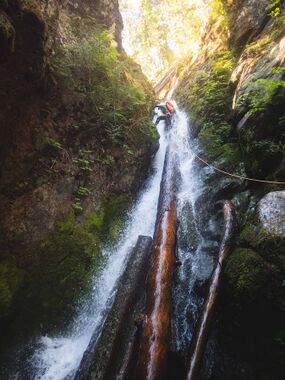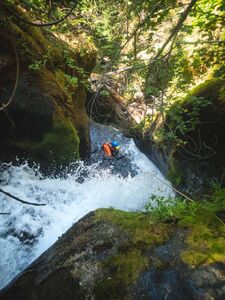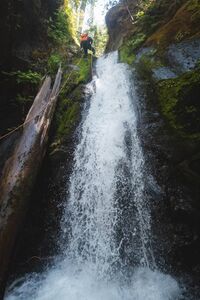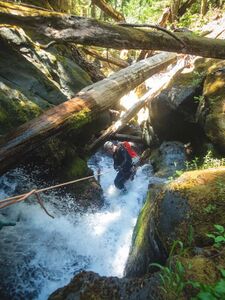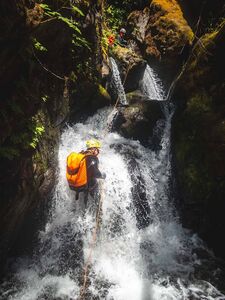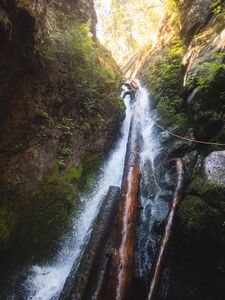Steel Creek
| Rating: | |||||||||||||||||||||||||||||||
|---|---|---|---|---|---|---|---|---|---|---|---|---|---|---|---|---|---|---|---|---|---|---|---|---|---|---|---|---|---|---|---|
| | Raps:6-10, max ↨70ft
Red Tape:No permit required Shuttle:None Vehicle:Passenger | ||||||||||||||||||||||||||||||
| Start: | |||||||||||||||||||||||||||||||
| Parking: | |||||||||||||||||||||||||||||||
| Condition Reports: | 8 Jul 2023
"No anchors or signs of previous passage were found, so this may have been a first descent. A couple of nice falls/sequences, but have to knock off a b |
||||||||||||||||||||||||||||||
| Best season: | May-Jul
|
||||||||||||||||||||||||||||||
| Regions: | |||||||||||||||||||||||||||||||
Introduction[edit]
Less steel and more wood. This would be a delightful little creek were it not for a plethora of trees (some of them mighty in girth) which have fallen into the drainage. Our team noted an excessive number of fallen trees in the area and pondered on the health of the local forest. It's an okay creek and has some interesting sequences, but there are certainly better destinations in the Skykomish River Valley. It's a lengthy drive to get out here.
Approach[edit]
Steel Creek is located about nine miles west/northwest of LeBar Creek on FR 2394. As of 2023, the road is in decent shape but becomes progressively more overgrown as one travels west. As of 2023, some enterprising four-wheelers had cut a route in as far as Tebo Creek, but gave up shortly thereafter. We parked and hiked the road in, but, in future, one might be able to drive all the way to Steel which would cut off a good chunk of the approach & exit. If you can drive to Steel, there's a nice pullout just before the road bends right.
Suit up at parking area, walk up the road a short distance, and descend into the creek wherever is easiest. A rappel might be required depending on where you enter the creek (R0). After checking the flow, head downstream. There are a couple of downclimbs before you reach R1.
Descent[edit]
DCR = Down Canyon Right DCL = Down Canyon Left
- R1: Two stage waterfall (15ft & 30ft) with a hanging pool between them. Rappel from a single bolt DCR. This sequence could be dangerous in high water.
- Below the falls is a neat chute-like feature that, unfortunately, was clogged with a logjam/strainer in 2023. We did two short nuisance rappels (~15ft each) to get down to the bottom.
Walk downstream a short distance.
- R2: 20ft from a log creek center into a mini-narrows with deep pool at the bottom. Swim out underneath a giant log. (Alternately, bypass DCR.)
- R3: 30ft down from log creek center down a trio of short, slippery tiers; more rope will be required per the horizontal distance.
- R4: 15ft from a log DCL.
- R5: Sequence of five short tiers ranging from 5-15ft all in a row. Requires about 80ft of rope to reach the bottom. Canyon appears to turn a corner halfway down, but an easy pull is achieved by running the rope over a large rock formation DCL. There is a big logjam at the bottom.
- R6: 30ft from log DCR.
- R7: 70ft down a person-sized crack from a single bolt DCL. This is the crux of Steel and could be quite dangerous in high water. Beware foot/body entrapment in a hidden dark crack/fissure near the top of the pitch. In 2023, a large log occupied most of the lower pitch.
(All photos c/o Wade Hewitt.)
Exit[edit]
After the finale, downclimb a few minor steps and exit the creek DCL whenever it looks feasible just before a lesser waterfall. You may want to de-wetsuit before beginning your exit thrash out, climbing about 300ft back up to the road. There is a lot of fallen trees (some giant old growth) in the area and we found that the going was okay staying in general proximity to the base of a cliff on climber's left, then eventually getting up on top when the terrain permitted. It's a bit steep in sections. From here it was a relatively easy bushwhack up to the road.
Red tape[edit]
None.
Beta sites[edit]
Trip reports and media[edit]
Background[edit]
Steel Creek was first descended in July 2023 by Kevin Clark, Wade Hewitt, Phil Newman, and Ashley Driscoll.
Further Explorations[edit]
Tebo Creek nearby looks like it has a number of drops, but it sports about 1/3rd the flow of Steel.
